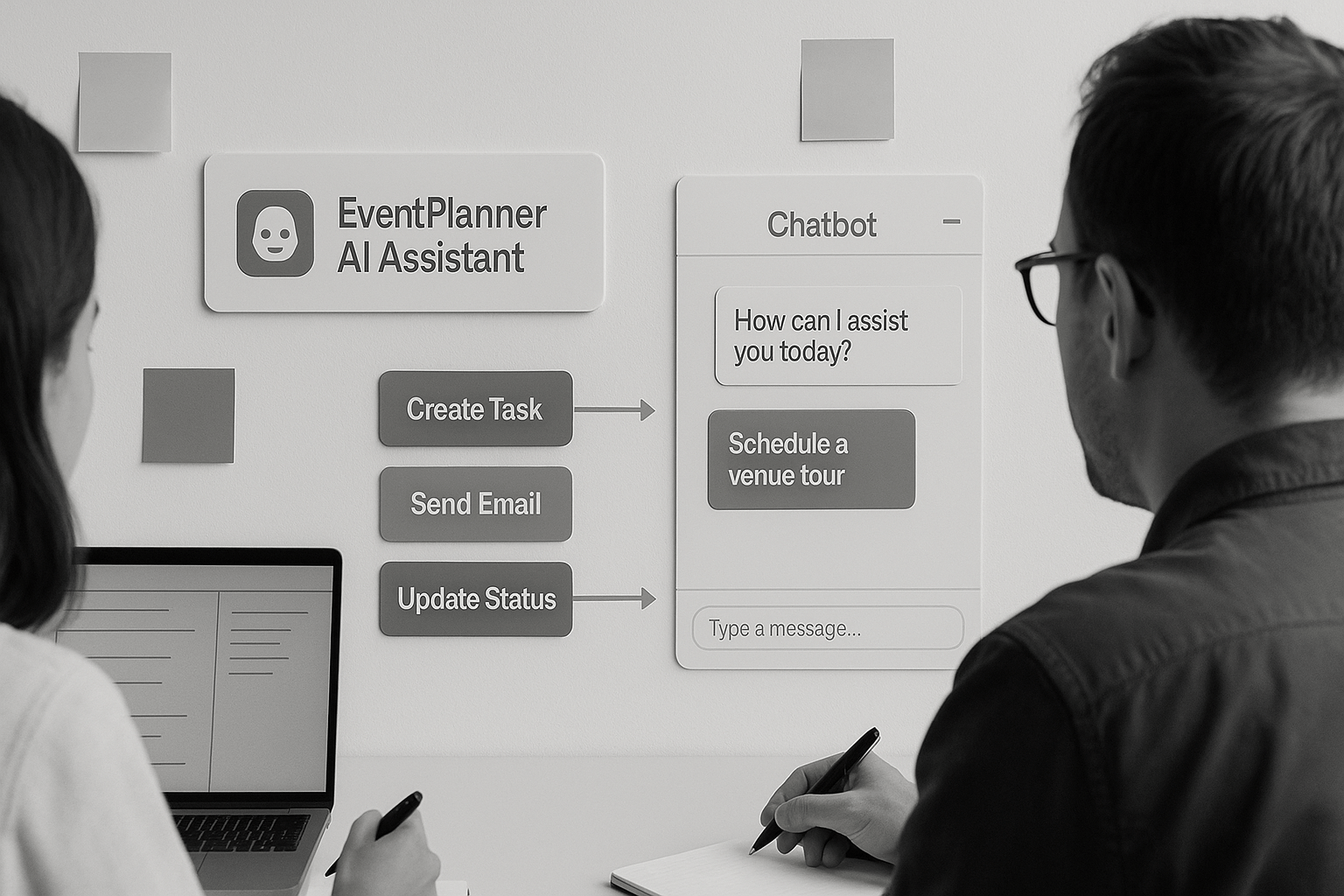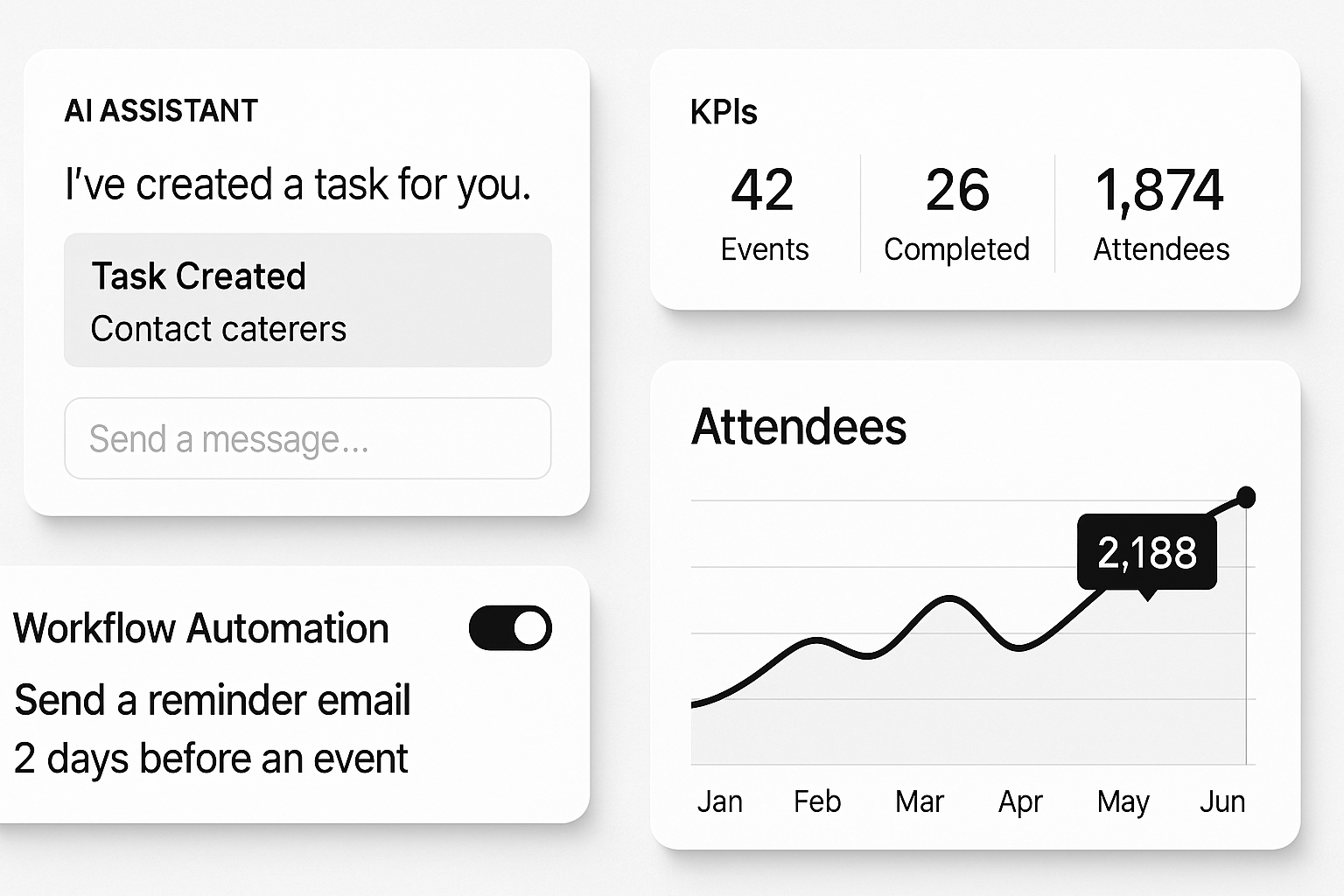Event Planners Success with Automation
by Design Delulu Editorial · September 24, 2025

Event planning is a high-stakes, detail-oriented industry where flawless execution is everything. But behind every successful event is a mountain of administrative work that can quickly overwhelm even the most organized planner. From managing vendors to tracking budgets and communicating with clients, the manual tasks are endless. This is where automation becomes a game-changer, helping event planners reclaim their time, reduce errors, and scale their business.

Why Event Planners Need Automation
Key Challenges They Face
Event planners juggle multiple complex projects at once, facing challenges like:
- Client Communication Overload: Constant back-and-forth emails, status updates, and decision approvals create communication chaos.
- Vendor Management Hell: Coordinating dozens of vendors, contracts, and payment schedules manually is a recipe for disaster.
- Inconsistent Processes: Without standardized workflows, each event becomes a custom project, making it difficult to scale efficiently.
- Repetitive Administrative Tasks: From sending reminders to creating timelines, manual admin work consumes valuable time that could be spent on creative planning.
How Automation Solves Them
Strategic automation streamlines these processes, allowing planners to focus on high-value work. Automated systems can handle client onboarding, send automated reminders to vendors, manage timelines, and even assist with budget tracking. The result is a more efficient, less stressful planning process that delivers better results for clients.

Essential Features of Automation for Event Planners
Must-Have Automation Tools and Workflows
- Client Relationship Management (CRM) Integration
Automated lead capture from your website, social media, and referral sources feeds directly into a comprehensive client database. Follow-up sequences nurture leads while automated project initiation workflows create standardized processes for new clients.
- Vendor Management Systems
Maintain automated vendor databases with performance metrics, availability calendars, and contract templates. Automated RFP distribution and response tracking streamline the vendor selection process while ensuring competitive pricing.
- Timeline and Task Automation
Create master timeline templates for different event types that automatically generate task lists, assign responsibilities, and set deadline reminders. These systems adapt to event-specific requirements while maintaining consistency across projects.
- Financial Management Tools
Automated invoice generation, payment processing, and expense tracking integrate with accounting software to provide real-time financial insights. Budget variance alerts notify you when costs approach predetermined thresholds.
- Guest Management Automation
From RSVP collection and dietary preference tracking to seating arrangement optimization and check-in processes, automated guest management reduces administrative burden while improving attendee experience.
Real-World Implementation Examples
Wedding Planning Automation: A wedding planner implemented automated client onboarding that reduced initial consultation preparation time from 3 hours to 30 minutes. The system automatically generates custom questionnaires based on venue type and guest count, creates preliminary timelines, and initiates vendor outreach.
Corporate Event Streamlining: A corporate event specialist developed automated proposal generation that pulls venue options, catering menus, and entertainment packages based on budget parameters and attendee count. This reduced proposal creation time by 75% while improving consistency and professionalism.
Festival Coordination: A music festival organizer implemented automated vendor communication systems that handle contract distribution, deadline reminders, and status updates across 50+ vendors, reducing administrative overhead by 60%.

Common Mistakes to Avoid
Typical Automation Pitfalls
- Over-Automation Without Personal Touch
The biggest mistake event planners make is automating client-facing communications to the point where relationships feel impersonal. While automation should handle routine tasks, high-touch interactions require human involvement to maintain the personal connection that sets successful planners apart.
- Implementing Too Many Tools at Once
Attempting to automate everything simultaneously often leads to system conflicts, staff overwhelm, and decreased productivity during the transition period. Successful automation requires gradual implementation with proper training and adjustment periods.
- Neglecting System Integration
Using multiple automation tools that don't communicate with each other creates new silos and potential points of failure. Ensure your automation stack includes proper integration capabilities or choose platforms that offer comprehensive solutions.
- Ignoring Mobile Optimization
Event planners work on-location frequently, yet many automation tools lack robust mobile interfaces. Choose solutions that work seamlessly across devices to maintain productivity regardless of location.
How to Implement Automation Successfully
Start with Your Biggest Pain Point: Identify the most time-consuming or error-prone process in your workflow and automate that first. Success with one system builds confidence and demonstrates ROI before expanding to other areas.
Maintain Human Oversight: Build review points into automated processes, especially for client communications and financial transactions. Automation should enhance human decision-making, not replace it entirely.
Train Your Team Thoroughly: Invest in comprehensive training for all team members who will interact with automated systems. Understanding both the capabilities and limitations of each tool ensures optimal utilization.
Regular System Audits: Schedule quarterly reviews of your automation systems to identify bottlenecks, update workflows, and eliminate redundant processes as your business evolves.
SEO and Growth Best Practices for Event Planners
Optimization Tips Specific to Event Planners
Local SEO Dominance: Implement automated review request sequences that encourage satisfied clients to leave Google My Business reviews. Set up location-based landing pages for different service areas and event venues you frequently work with.
Content Marketing Automation: Create automated blog posting schedules featuring recent events (with client permission), seasonal planning tips, and vendor spotlights. This consistent content creation improves search rankings while demonstrating expertise.
Social Media Integration: Automate social media posting of event highlights, planning tips, and behind-the-scenes content. Use scheduling tools to maintain consistent presence across platforms without daily manual posting.
Email Marketing Sequences: Develop automated nurture sequences for different client segments (wedding planners, corporate events, social celebrations) that provide valuable content while keeping your services top-of-mind.
Leveraging Automation for Visibility and Results
Automated Testimonial Collection: Set up post-event surveys that automatically request testimonials and reviews. Positive feedback gets funneled to your website and social media, while constructive criticism enables service improvements.
Performance Analytics: Implement tracking systems that monitor website traffic, lead conversion rates, and client satisfaction scores. Automated reporting provides insights for strategic decision-making without manual data compilation.
Referral Program Automation: Create systems that automatically thank existing clients for referrals and track referral sources. This helps identify your most valuable client relationships while ensuring proper acknowledgment of referral partners.
Lead Scoring and Nurturing: Develop automated lead scoring systems that identify high-potential prospects based on budget, event size, and timeline. Tailored nurture sequences convert more leads while focusing your personal attention on the most promising opportunities.
Measuring Automation Success
Key Performance Indicators for Event Planners
- Time Savings Metrics: Track hours saved on administrative tasks, client communications, and vendor coordination. Successful automation should free up 15-20 hours per week for strategic activities.
- Error Reduction: Monitor decreases in booking conflicts, budget overruns, and communication mishaps. Quality automation systems should reduce operational errors by at least 50%.
- Client Satisfaction Scores: Measure improvements in client communication response times, project timeline adherence, and overall satisfaction ratings.
- Revenue Growth: Track increases in concurrent projects managed, profit margins, and client retention rates as automation enables more efficient operations.
Future-Proofing Your Event Planning Business
Emerging Automation Trends
- AI-Powered Vendor Matching: Advanced algorithms that automatically suggest optimal vendor combinations based on event requirements, budget constraints, and past performance data.
- Predictive Analytics: Systems that forecast potential issues, optimal pricing strategies, and resource allocation based on historical data and market trends.
- Virtual Reality Integration: Automated VR venue tours and event visualization tools that enhance client presentations while reducing site visit requirements.
- Blockchain Contract Management: Automated smart contracts for vendor agreements that trigger payments based on milestone completion and performance criteria.
Getting Started with Automation
Implementation Roadmap
Phase 1 (Months 1-2): Implement basic CRM automation and email marketing sequences. Focus on lead capture and initial client communication workflows.
Phase 2 (Months 3-4): Add project management automation and basic vendor communication systems. Integrate financial tracking and reporting tools.
Phase 3 (Months 5-6): Deploy advanced scheduling systems, guest management automation, and comprehensive analytics dashboards.
Phase 4 (Ongoing): Continuously optimize existing systems, explore emerging technologies, and expand automation capabilities based on business growth.
Conclusion
Automation represents a fundamental shift in how successful event planners operate, moving from reactive task management to proactive strategic planning. By implementing the right combination of tools and workflows, event planners can reduce administrative burden, improve client satisfaction, and scale their businesses without proportional increases in stress or overhead.
The key to successful automation lies in thoughtful implementation that enhances rather than replaces the human elements that make events memorable. Start with small wins, measure results carefully, and gradually expand your automation capabilities as your team becomes comfortable with new systems.
Remember that automation is not about replacing creativity or personal relationships—it's about creating space for them to flourish by handling the routine tasks that consume valuable time and mental energy.
Ready to improve your event planning business with automation? Explore Design Delulu's Automation Services to discover how we can help streamline your operations and accelerate your growth.
For more insights and tools, visit our portfolio or book a call to discuss your specific automation needs. Don't forget to check out our helpful tools designed specifically for event planning professionals.
Let's level up your Event Planning Automation
Need automation that actually moves the needle for event planners? See our approach, pricing, and timelines—then book a quick call.